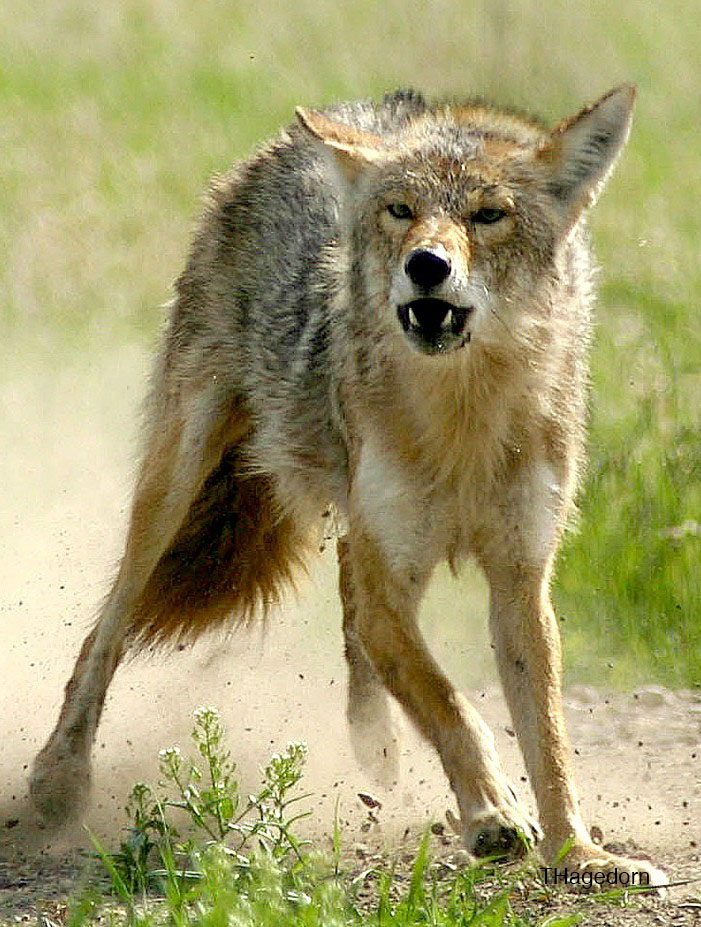| |  Lamb producers in Alberta lose sheep to a number of different predators including bears, cougars, wolves, eagles, ravens and magpies. Despite the variety of predators, coyotes are responsible for the majority of predation losses across the province. While the losses are relatively low when spread over the entire industry, individual producers can have significant losses in any given year. Lamb producers in Alberta lose sheep to a number of different predators including bears, cougars, wolves, eagles, ravens and magpies. Despite the variety of predators, coyotes are responsible for the majority of predation losses across the province. While the losses are relatively low when spread over the entire industry, individual producers can have significant losses in any given year.
In most areas of Canada managing predation has become an integral part of flock management. Managing predation, like managing flock health and nutrition, contributes to optimum flock productivity. Flock productivity is critical for the economic well-being and viability of sheep enterprises.
Added to the need for profitability are the ever-changing conditions that impact sheep production. Predator species native to Canada have been re-establishing their historic territories. In some cases they are increasing in numbers and are now accepted as “part of the natural landscape”. There is increasing social pressure for livestock producers to learn to live with wildlife, and that includes predator species. Society may accept the need to remove a predator that is killing livestock but the indiscriminate removal of predators is no longer acceptable to most producers or society.
There is no one tool or single preventative measure that will be equally effective in all flocks for all predators. The goal of a predation management plan is to reduce predation to a level that is tolerable to the individual flock manager. An effective management plan includes: good flock husbandry; the use of guardian animals; good fencing; the proper disposal of dead animals; and appropriate techniques for dealing with problem predators.
Know the rules and regulations
How you deal with wild predators falls under the jurisdiction of the Fish and Wildlife Act, as well as the Agricultural Pests Act for coyotes.
- Management of predation on livestock is regulated, in part, by the Agricultural Pests Act, and the Pest and Nuisance Control Regulations (184/2001). (Alberta RSD. 2010)
- Coyotes are listed as nuisance animals under the Agricultural Pests Act. That means producers have more options in how they deal with problem coyotes, but it also means that dealing with them is the landowner’s/producer’s responsibility.
- Hunting of wolves, black bears, coyotes and cougars is allowed on privately owned land by the owner or occupant of that land, or a resident who is authorized by the owner or occupant of that land to hunt on the land, or on public land by a person authorized to maintain livestock on that land, or a resident who is authorized in writing by the livestock owner to hunt on the land. Alberta Guide to Hunting Regulations
- Grizzly bears and eagles are protected in Alberta and cannot be killed or harassed.
Where to go for information or assistance
- Predation by wolves, grizzly bears, black bears, cougars and eagles is to be reported to the nearest Fish and Wildlife office. Go to the Fish and Wildlife Information Centre:
- Wildlife Predator Compensation Program provides compensation for losses and damages to livestock by wolves, grizzly bears, black bears, cougars and eagle, but not coyotes.
- Damage Control Licenses provide legal authority to hunt or trap the nuisance wildlife to attempt to minimize damages to livestock or property. Contact your district Fish and Wildlife office to determine whether a damage control license is required.
- The Coyote Predation Management Program is to inform and assist landholders in managing coyote predation of their livestock. It is administered through a joint co-operative agreement between Alberta Agriculture and Forestry (A&F) and participating rural municipalities. Additional program details can be found at http://www1.agric.gov.ab.ca/general/progserv.nsf/all/pgmsrv403 and by reviewing the Coyote Predation Control Manual and Study Guide
- Predation by domestic or feral dogs should be directed to the local RCMP detachment office.
The Alberta Predation Management Manual was developed to provide Alberta producers with practical predation management options as well as background information on predator species, particularly coyotes.
|
|